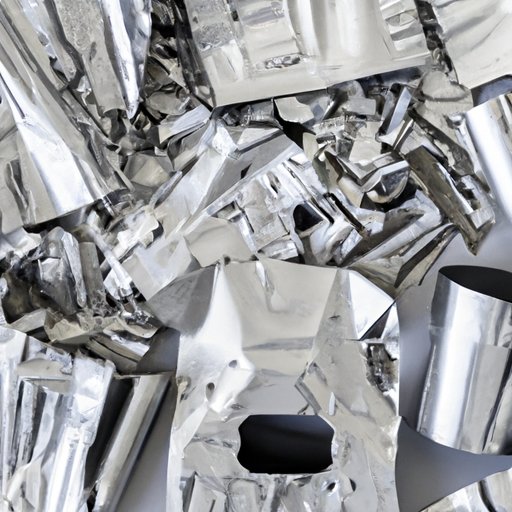Introduction
Aluminum is a lightweight metal found in abundance in the Earth’s crust. It is one of the most abundant elements on the planet and has a variety of uses. In this article, we will explore what aluminum is, how it is used, its advantages and disadvantages, its role in the automotive industry, and the environmental impacts of aluminum production and recycling.
Overview of Aluminum: What is it and How is it Used?
Aluminum is a silvery-white metal with a range of properties that make it an appealing material for use in a variety of applications. It is lightweight but strong, durable, and corrosion-resistant. These qualities make it ideal for use in everything from construction to transportation, consumer products, and beyond.
Aluminum can be found in a variety of products, from cans and packaging to cookware, furniture, and even electronics. It is also used in the automotive industry for car bodies and wheels, as well as for engine components. Other uses include aircraft parts, boats, and even spacecraft.

Examining the Advantages and Disadvantages of Aluminum
Aluminum offers many advantages over other materials. For example, it is lightweight and strong, making it ideal for use in vehicles and aircraft where weight is a factor. It is also non-magnetic, corrosion-resistant, and highly conductive, which makes it useful in electronics and electrical applications. Additionally, aluminum is highly recyclable, making it an environmentally friendly choice.
There are some potential drawbacks to using aluminum, however. For example, it is not as strong as some other metals, such as steel or titanium, so it may not be suitable for certain applications. Additionally, aluminum is susceptible to fatigue and stress cracking, so it must be carefully designed and manufactured to avoid these issues.
Exploring Aluminum’s Role in the Automotive Industry
Aluminum has been used in the automotive industry since the early 1900s. Initially, it was used mainly for decorative elements, such as trim and body panels. Over time, however, aluminum began to be used more extensively in the manufacture of cars and trucks. Today, aluminum is used extensively in the automotive industry for body panels, wheels, engine blocks, and other components.
The use of aluminum in the automotive industry offers several advantages. For starters, aluminum is lighter than steel, which reduces the overall weight of the vehicle. This, in turn, improves fuel efficiency and reduces emissions. Additionally, aluminum is resistant to corrosion, so it is less likely to rust over time. Finally, aluminum is relatively inexpensive, making it a cost-effective material for car manufacturers.

A Look at Aluminum Products and Their Uses
Aluminum products come in a variety of shapes and sizes. Common types of aluminum products include sheets, bars, rods, tubes, angles, and extrusions. These products can be used for a variety of applications, including construction, manufacturing, automotive, and aerospace.
For example, aluminum sheets are often used in roofing, siding, and other building applications. Aluminum bars, rods, and tubes are commonly used in the automotive industry for structural components and engine parts. Angles and extrusions are often used for window frames and other architectural applications. Additionally, aluminum can be used to make cookware, furniture, appliances, and other consumer products.

Investigating the Environmental Impact of Aluminum Production
The production of aluminum can have a negative impact on the environment. The process requires large amounts of energy and can emit pollutants, such as sulfur dioxide, nitrogen oxides, and particulate matter. Additionally, aluminum production results in the release of greenhouse gases, such as carbon dioxide, which can contribute to global warming.
To reduce the environmental impact of aluminum production, manufacturers are developing strategies to reduce energy consumption and emissions. For example, they are investing in renewable energy sources, such as solar and wind power, to power their operations. Additionally, they are exploring ways to capture and store emissions, such as carbon dioxide, to prevent them from entering the atmosphere.
Aluminum Recycling: Its Benefits and Challenges
Recycling aluminum is a great way to reduce waste and conserve resources. When aluminum is recycled, it can be melted down and reused to create new products. This helps reduce the amount of energy and materials needed to produce new aluminum products.
Recycling aluminum also helps reduce pollution. Since aluminum production is energy-intensive and emits pollutants, recycling aluminum reduces the need to produce new aluminum and helps keep pollutants out of the air. Additionally, aluminum recycling helps reduce landfill waste, since aluminum cans and other aluminum products can take up to 500 years to decompose.
Although aluminum recycling is beneficial, there are some challenges associated with it. For example, it can be difficult to separate aluminum from other materials, such as plastics and paper, which are often mixed together in the recycling process. Additionally, aluminum is often contaminated with food or other materials, which can make it difficult to recycle.
Conclusion
Aluminum is a versatile material with a variety of uses, from construction to transportation. It is lightweight and strong, corrosion-resistant, and highly recyclable, making it an environmentally friendly choice. Although there are some potential drawbacks to using aluminum, such as fatigue and stress cracking, its benefits generally outweigh its disadvantages. Additionally, aluminum is widely used in the automotive industry and can be recycled to help reduce waste and conserve resources.

